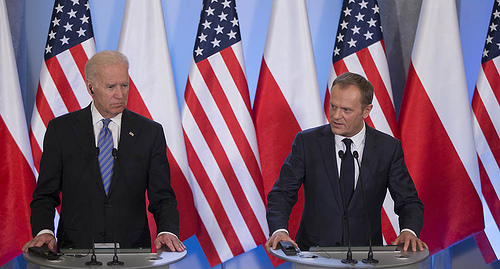
Russia’s annexation of Crimea has suddenly revived the North Atlantic Treaty Organization’s central role as a counterweight to Moscow, and with it questions about the alliance’s options and ability to act.
Vice President Joseph R. Biden Jr. swept into Poland and the Baltic nations on Tuesday with a message of reassurance that their membership in NATO carries the protection of the United States. But given deep Western reluctance to use military force in response to Russia’s aggression, it remains unclear what the alliance’s commitment to collective security means for Ukraine and other nonmembers should President Vladimir V. Putin continue to try to expand Moscow’s influence in the former Soviet bloc.
Ian Bond, the director of foreign policy at the Center for European Reform, a London-based research group, said that “Putin has just given NATO something to do, but the question is whether NATO is up to it.” It is now crucial to deter further moves by Mr. Putin, he said. “If Russian forces move into eastern Ukraine,” he said, “what would NATO do?”
The Atlantic alliance was designed, as the old phrase went, to keep the Americans in, the Germans down and the Soviets out. Now, with Mr. Putin acting more like a Cold War antagonist, arguing that Russia has the right to defend Russians everywhere, the United States will be under more pressure to sustain and exhibit military strength in Europe despite the much ballyhooed “pivot to Asia.”
Since the Ukraine crisis began, the United States, in the context of the alliance, has sent more F-16 fighters to Poland and F-15 fighters to the Baltics. It has begun Airborne Warning and Control System, or Awacs, flights over the Polish and Romanian borders, and has ordered more exercises with warships in the Black Sea.
“As NATO allies,” President Obama said on Monday, “we have a solemn commitment to our collective defense, and we will uphold that commitment. . . .”
In recent years, even the commitment of Washington to Article 5 has been questioned as the United States has sought an accommodation with Russia and emphasized a growing threat from China. It was not until 2009, a senior NATO official said, that a war-fighting contingency plan to defend the Baltics was even drawn up, five years after they joined the alliance and were promised collective defense. . . .
The alliance has never figured out how to handle the countries, like Ukraine, Moldova and Georgia, stuck between Russia and NATO, said James Goldgeier, dean of the School of International Service at American University. “We never came up with a solution for the insecurity of that area, and we still don’t have one,” he said. “We’ve known for a long time that relations with the United States are not that important to Putin, and making sure Ukraine doesn’t go West is a lot more important to him.”
Robin Niblett, the director of Chatham House, the Royal Institute of International Affairs, said that “Putin could not have scripted this better for those who believe in the continuing relevance of NATO.”
The alliance is coming home after long years in Afghanistan and its limited but vital role in Libya, Mr. Niblett said, amid divisions within the alliance about its role. “But Putin has raised, even more than Slobodan Milosevic in Kosovo, concerns about events that we thought could no longer happen on the European continent,” he said.
“There’s still a 19th- and 20th-century Europe alongside the 21st-century one,” Mr. Niblett said. “We thought Russia could change, was changing. But Putin has taken it in another direction, consolidating power in a crude form.”
Image: Vice President Joe Biden and Polish Prime Minister Donald Tusk, March 18, 2014 (photo: Office of the Prime Minister of Poland)

